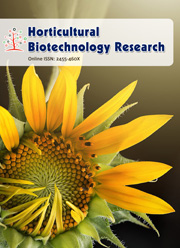Determination of Apposite Plant Regeneration Protocol for Several Cucurbits through Direct and Indirect Organogenesis
DOI:
https://doi.org/10.25081/hbr.2019.v5.5279Keywords:
callus, cotyledon, Cucurbita, in vitro, regeneration, organogenesisAbstract
A competent and reproducible practice for the invitro shoot regeneration of Cucurbita maxima,C.pepo and Cucumissativus was developed from various explants through direct and indirect organogenesis.InC. maxima, between cotyledon and leaf segment, cotyledon was found to be most responsive for callus induction in MS medium augmented with 0.5 mg·L-1 2,4 dichlorophenoxy acetic acid (2,4-D) plus 100 mg·L-1 casein hydrolysate and 0.5 mg·L-1 2,4-D plus 15% coconut water and for leaf segment it was on MS medium containing 2.5 mg·L-1 2,4-D. Comparing the 2 explants it was found that leaf segment was most suitable for callus induction in C. maxima. For massive multiplication of C. pepomericlones shoot tip and nodal cutting were used. MS medium containing 3.0 mg·L-1 6-benzyl aminopurine plus 0.5 mg·L-1gibberellic acid (GA3) was found most effective for shoot regeneration and 1.0 mg·L-1 IBA was found most effective for rooting. In this trait cv. Bulum was more responsive than cv. Rumbo. On the other hand, to generate virus free plantlets of C. sativus, different concentrations of kinetin were used, and 1.5 mg·L-1 KIN shown the best performance for primary culture establishment. For shoot multiplication, 1.0 mg·L-1 BAP and 2.0 mg·L-1 BAP plus 0.5 mg·L-1 KIN containing medium shown best result. Subsequently, 2.0 mg·L-1 BAP plus 0.5 mg·L-1 KIN was best composition for root induction. Our report demonstrated comprehensive protocols and variability in explants, growth regulator response in shoot regeneration potential of in different cucurbit plants.



 .
.